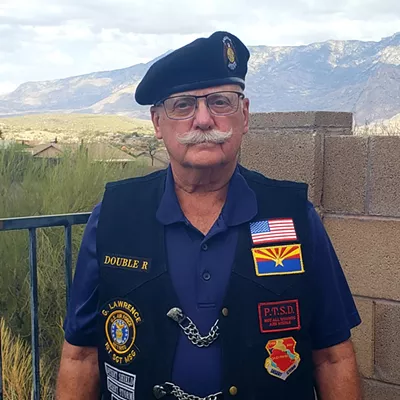It's Saturday night, but Gary Bjorklund isn't in the mood for a party.
For several years, his small but vibrant gallery has inhabited various spots inside a former Firestone tire store on the corner of Sixth Street and Sixth Avenue. But tonight marks the end, says Bjorklund, even as patrons stream past as part of a downtown-area arts walk.
With a sputtering economy and what Bjorklund sees as the city's lackluster support for the arts, he's more than ready to pull the plug on his struggling business.
"I used to have UA students come in and buy prints," he says. "That was one of my favorite things—for many of them, it was probably the first time they'd ever bought any art." Now, with tuition rising, and parents no longer able to pad student lifestyles, those college kids have largely vanished.
Still, Bjorklund reserves most of his blame for city government, which he believes has failed spectacularly at implementing downtown's Rio Nuevo redevelopment project. He was hoping Rio Nuevo's energy would spill over to his own business. Instead, he's seen his hopes dashed.
"The city has been making promises to us for so long," he says. "But it hasn't amounted to anything."
While opinions on Rio Nuevo differ, few would call it an unqualified success. However, no one can argue with the fact that city and county governments have also slashed arts funding, even though studies show that the arts—including Bjorklund's little gallery—could play a key role in our community's economic recovery.
Those cuts battered the Tucson Pima Arts Council, which was created more than two decades ago to distribute grants and other public funds among local groups. Now the council itself is on unsure footing.
"Our funding from the city and the county was decreased this year by nearly 50 percent," says David Hoyt Johnson, the council's deputy director. "One of our principal missions is to manage the mechanism of 're-granting' whatever public funding was available to support the arts. And that's obviously been one of the first things cut."
Karin Uhlich represents Ward 3 on the Tucson City Council. She says cuts to arts funding are among the toughest decisions she's been forced to make. "There's no doubt that our investment in the arts is returned many times over, because it strengthens the economy and tourism in Tucson. But in these really difficult times, it's more a matter of (maintaining) the city's core functions of public safety, parks and recreation, and transportation. Quite frankly, even our investments in economic development have had to be looked at again and trimmed."
There's more than a coincidental connection there, since many argue that the arts fall directly into the economic development category. Among those advocates is Americans for the Arts, a nonprofit advocacy group based in Washington, D.C.
In 2007, the organization profiled 156 "study regions" across the country, including Pima County. According to a subsequent report, the arts and culture industry generates more than $166 billion nationally each year in economic activity. That provides almost $30 billion in revenue for local, state and federal governments.
In Pima County, the study showed that arts and culture annually generated nearly $60 million in economic activity. Three years ago, that translated to 1,700 full-time jobs, and $30.42 million in household income to area residents.
Those numbers have not gone unnoticed at Tucson Regional Economic Opportunities, Inc. Largely funded by taxpayers, the agency is charged with boosting the local economy and attracting new businesses to town. Recently, contacts between TREO and the Arts Council have grown more frequent, for one simple reason: Arts and culture are among Tucson's top selling points.
"We do see the arts as an important part of the economy," says Laura Shaw, TREO's vice president for marketing and communications. "From the economic-development perspective, things have changed quite a bit in the last 10 or 15 years, in terms of the need of trying to attract the creative class."
She's referring to a concept, forwarded in The Rise of the Creative Class by author Richard Florida, that creativity will play an increasingly important economic role. Indeed, Florida argues that the creative class—which includes everyone from writers and artists to scientists—will become a determining factor in our collective prosperity. Not surprisingly, that creative cohort places a premium on arts and culture.
"We really subscribe to the notion that we need to be able to attract and retain the right talent in order to attract and retain the right jobs," Shaw says. "We're really on the side of building a great community that people will want to come to—that has all the amenities that young professionals want—and the arts are a part of that."
Over at the Davis Dominguez Gallery on Sixth Street, co-owner Mike Dominguez suggests that the "creative class" also includes people new to the arts. He hopes to broaden that category through a group he spearheads called the Central Tucson Gallery Association. Among other things, the association hosts art tours to attract folks who otherwise might not see themselves as arts patrons.
"The more people who enjoy high culture, the better it is for everybody," Dominguez says. "I'm a real nut about this industry in town. People don't think about the arts as an industry, but we've got workers and products and institutions and a market. We generate taxes, and people who work in the industry also create a demand for goods and services."
He admits that "a lot of people in the business community don't think of us in that way. But if they really look at what an industry is, we certainly fit."
The same goes for city officials.
"It's not as critical of an issue for them at any point in time—they've got other things that are bigger and more pressing, that have to do with hard economics and the tax base," he says. "But we're part of that tax base, too."






